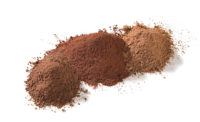Chocolate and cocoa pair well with dairy products
Chocolate and cocoa are long-time associates of dairy. These days, everything from frozen yogurt to blended coffee beverages is angling for a chocolaty profile. A panel of experts explains how to formulate with the ingredients.






Dairy Foods:Chocolate milk poses an interesting paradox. It’s controversial in some school lunchrooms but touted as an ideal sports recovery beverage. Any comments?
Stunek:Paradox is a good word for it. Twenty or thirty years ago in school we were drinking full-fat milk with probably 27 grams of sugar. It didn’t seem to be an issue for us health-wise; then again we didn’t come home from school and sit in front of the TV for the rest of the day, either.
Kids certainly cut back their consumption of milk when chocolate is not offered in schools. Unfortunately this reduces their intake of calcium, vitamin D and other nutrients they really need. On the good side, chocolate milk has gotten a lot of positive press for sports recovery. The carb-protein-vitamin combination is what makes it so good for you. I would like to see more dairies promote it in this manner by sponsoring athletic events and teams. As difficult as it is for small dairies to battle for dairy’s image on a national level, it can be done on a local level.
Dairy Foods:What low-sugar, low-calorie and/or low-fat chocolate and cocoa ingredients help us formulate school-friendly chocolate dairy products? What taste or texture tradeoffs might they entail?
Stunek:The toughest part of formulating school milk is dealing with the skim requirement. In my opinion, there is almost nothing you can do at the required cost to mask that lack of fat. Going from 3.25% to 2% fat or from 2% to 1% is stepping down a bit. Going from 1% to skim is like jumping off a cliff. It makes that much of a difference.
Ultimately it comes down to getting the proper cocoas that work well with the skim milk and sugar target. Different sugar levels require different cocoa blends. There is no one cocoa that is right for everyone.
Additionally, there has been an increased use of sweetener modulators that are effective in making the product taste sweeter than the 22 grams of sugar or less that some districts require.
Dairy Foods:What does “sustainability” mean with respect to cocoa and chocolate ingredients?
Stunek:Sustainable cocoa is cocoa produced using sustainable practices that encompass growing methods, employee safety, worker age restrictions and other criteria. There are certifying bodies for this. However, the large cocoa buyers as a whole have also worked to improve conditions on all these farms regardless of whether or not they are certified.
Dairy Foods:What tradeoffs — in cost, functionality, sourcing reliability — come with formulating with sustainable chocolate and cocoa ingredients?
Stunek:In a nutshell, you are paying more for a less consistently available product. Committing a large portion of your supply to sustainable cocoa would be a very risky proposition. There is a reason the large candy makers haven’t already converted to full sourcing of sustainable beans: because there aren’t enough certified sustainable farms yet. That will likely work itself out over time as more sources of sustainable beans become available. But right now I would say we are still in the early stages of developing this whole practice on a certified basis.
Looking for a reprint of this article?
From high-res PDFs to custom plaques, order your copy today!










